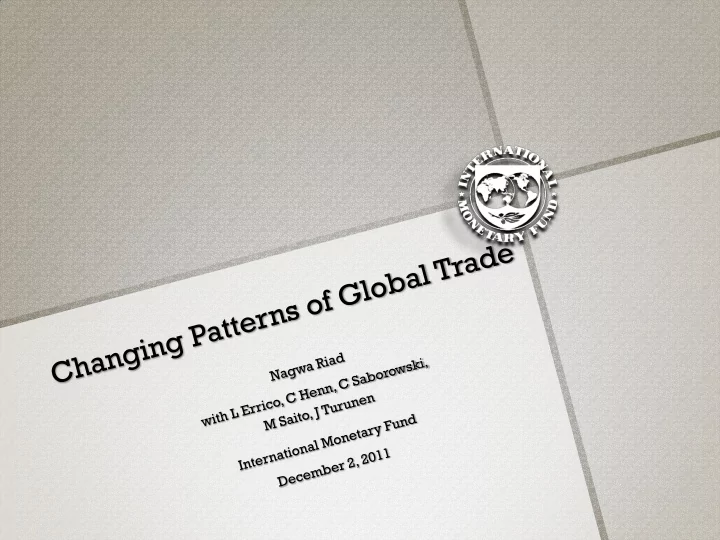

Global trade has grown significantly…. • World exports 26 percent of GDP in 2008 • Export growth driven by three (inter-related) factors: - Trade liberalization - Rise in vertical specialization - Income convergence 2
Outline Three analytical approaches: • Network analysis • Value-added based analysis • Rebalancing analysis based on a partial equilibrium approach 3
Interconnectedness (1) Network analysis — two stage process • Ranking by size and interconnectedness indicators • Size: exports, imports, overall trade, overall trade in percent of GDP • Interconnectedness: in-degree, closeness, betweenness, prestige • Overall composite index = 0.8 size + 0.2 interconnectedness 4
Interconnectedness (2) 5
Interconnectedness (3) 6
Interconnectedness (4) 7
Global Supply Chains (1) • Vertical specialization has increased since mid- 1990s…. • Contribution of FVA to exports growth also rising 8
Global Supply Chains (2) • Advanced economies upstream… • EMEs downstream 9
Global Supply Chains (3) • Vertical specialization increased especially for China… • ….associated with regional concentration • …and rising share of Chinese FVA in advanced economies’ exports 10
Global Supply Chains (4) • Growth in high technology exports in advanced economies entirely due to FVA…. • China’s share of FVA is high in exports of high and med- high technology products 11
Global Supply Chains (5) Regional characteristics: • Dependence on regional power house • Extent of processed value added flowing back to hub Importance of upstream country in supply chain resilience to shocks 12
Rising export similarity between EMEs and advanced economies… 13
Rising export similarity between EMEs and advanced economies… 14
Implications for Trade Outlook • Integration of rapidly growing EMEs likely to shift sources of global demand away from advanced economies • Emergence of global supply chains may have changed the way trade responds to relative price changes 15
Rebalancing: Model (1) • Simple model combining partial equilibrium Model approach with I-O analysis to analyze the response of sectoral trade flows to changes in relative prices Two-steps • Differences in import demand and substitution elasticties, and in imported content in production, result in shifts in sectoral trade structure; • I-O tables to determine change in composition of import demand due to shift in export structure 16
Rebalancing: Model (2) • Imports at the 6-digit level 162 countries in Data COMTRADE • Highly disaggregated micro-level trade elasticities: import demand elasticity HS 6-digit (Kee et al, 2008); substitution elasticity HS 2-digit (Broda and Weinstein, 2006) • Simulation United States, Japan (10-percent depreciation); China and Euro Area (10-percent appreciation 17
Rebalancing: Aggregate Results • Changes in relative prices result in sizable long-run responses in trade flows and rebalancing effects • A downstream position in a supply chain cushions impact of relative price change on exports and imports • Imperfect exchange rate pass- through likely to mitigate adjustment in trade flows to exchange rate changes • Adjustment in trade flows gradual given high fixed costs in production and trade relationships 18
Rebalancing: Sectoral Effects (1) • An appreciation results in an increase in the share of high- technology exports in China and to a lesser extent in the Euro Area… • A depreciation results in important shifts in the share of medium-high-technology exports in Japan and the United States 19
Rebalancing: Sectoral Effects (2) • Exports to supply chain partners are broadly resilient to relative price changes • cost of breaking up trade relationships may be particularly large in a supply chain • simulation countries dominant players in their regional supply chains in terms of volume and value of exports • … but suppliers of intermediates can be impacted severely when exports fall in response to exchange rate appreciation 20
Policy Implications • Increased interconnectedness strengthens trade spillover channels • Growing importance of global supply chains further increases the international transmission of shocks, including policy-induced ones • Rebalancing effects are relatively small in China due to its downstream position • Real exchange rate shifts of the magnitude considered would not result in substantial reorganization of trading networks and production chains 21
Future Research • Global Supply Chains 2.0 - REER using value added trade data - Trade interconnectedness using value added data - Demand spillovers along supply chain countries - Effects of demand fluctuations on protectionist pressures • Cluster-based surveillance 22
Thank you 23
EMEs important players in global trade…
Optional • Japan is an important source of FVA in many Asian countries’ exports a disruption in production of sophisticated intermediate inputs may test resilience of supply chains
Recommend
More recommend